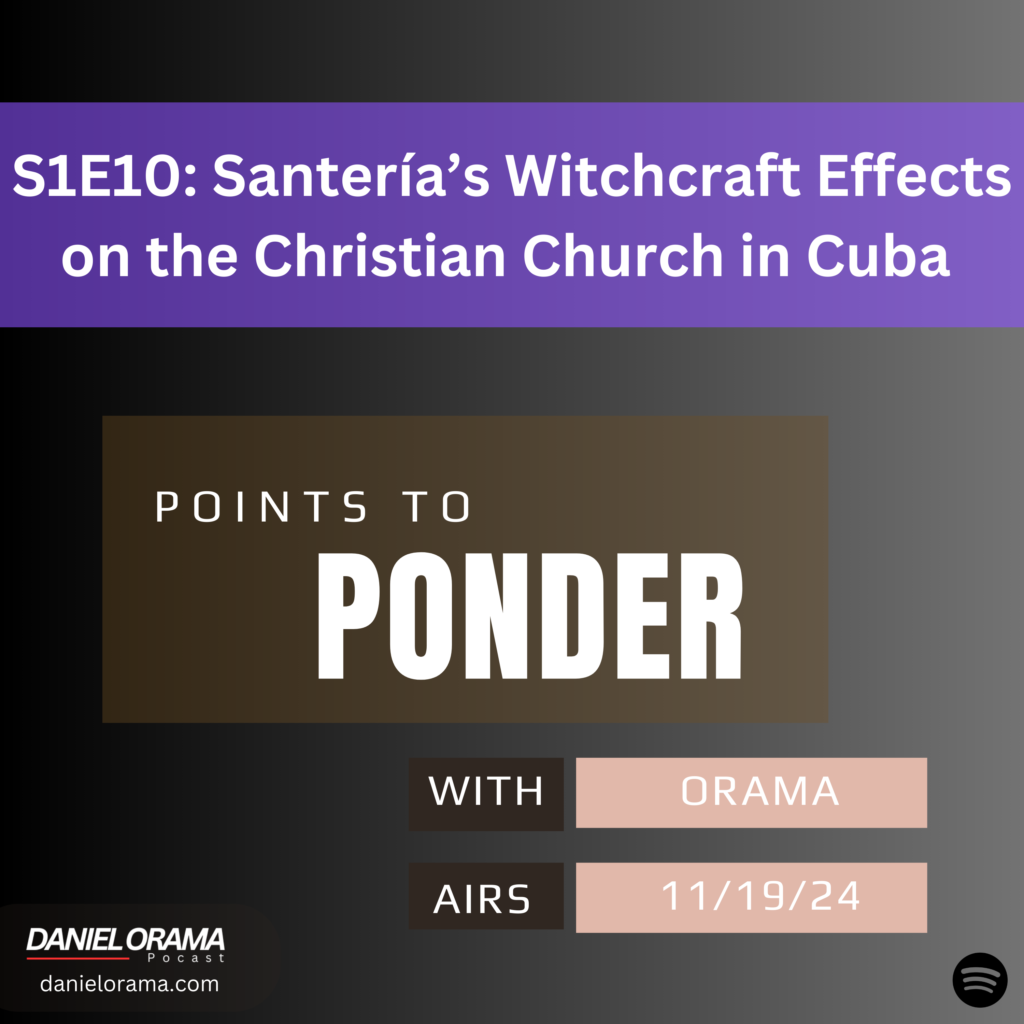According to the New World Encyclopedia
“Santeria (Santería in Spanish, meaning “Way of the Saints”) is a set of related religious systems that fuse Roman Catholic beliefs with traditional Yorùbá beliefs that, over time, became a unique religion in its own right. Properly known as Lukumí in the Yorùbá language, meaning “friendship,” Santeria was the religion practiced by descendants of many Yorùbá slaves in Cuba, over time growing in popularity with many people in Latin American countries and eventually spreading to many regions of the Americas. Estimates of the number of practitioners of Santeria are difficult due to its decentralized structure, autonomy of individual house temples, and Santeria’s relaxed approach to other religions. However, most estimates suggest about four million adherents worldwide, about three-quarters of which reside in Cuba.”
Christian Church in Cuba Encountered Opposition
The Christian church in Cuba encountered opposition from various sources, including Santería. Santería, which originated in Cuba, emerged from the unification of religious beliefs and practices of enslaved Africans, the Roman Catholic Church, and French spiritism. According to Harry G. Lefever, “What emerged from the encounter of these three traditions was a new syncretized religion that was neither African, Roman Catholic nor spiritist but which borrowed elements from all three.”[1] Much of these beliefs came from the imported slaves. The arrival of the first enslaved people in Cuba dates back to the sixteenth century. However, it was not until the nineteenth century that a new wave of slaves, particularly the Yoruba from southwestern Nigeria and, to a lesser extent, the Bantu from the Congo, arrived. These later arrivals were the primary bearers of African religious beliefs and practices, significantly influencing the development of Santería.
Ten Beliefs of the Yoruba
There are ten beliefs of the Yoruba, but author David H. Brown covers a few in his work, Santeria Enthroned. “There are ten essential components of Yoruba religious belief and practice:
- The Yoruba believe that there is one God who created and controls the universe and all that is contained therein;
- The Yoruba believe that there are forces of nature (or parts of God) who deal with the affairs of men on earth and the governing of the universe in general;
- The Yoruba believe that the spirit of man lives on after death and can reincarnate back into the world of men…
- The Yoruba believe that man can commune with God through the vehicle of tran[ce]-possession—John Mason, Black Gods: Orisa Studies in the New World.”[2]
Trance possession? Okay, before we tackle this Trance possession, what do you notice about these beliefs? They all state what the Yoruba believe and not what the Word of God says. So, what is it, Trance Possession? The APA dictionary of psychology defines it, “In possession trance, the individual’s usual identity is replaced by a new identity perceived to be an external force, such as a ghost, another person, or a divine being, and there is loss of memory for the episode of trance.” Did you notice that they refused to use the word demon? Does the Bible mention anything about this type of possession? I am glad you asked.
Mark 1:23-28 states, “Now there was a man in their synagogue with an unclean spirit. And he cried out, 24 saying, “Let us alone! What have we to do with You, Jesus of Nazareth? Did You come to destroy us? I know who You are—the Holy One of God!” Wow! Even the demons know who Jesus is, but many in the world do not.
But Jesus rebuked him, saying, “Be quiet, and come out of him!” And when the unclean spirit had convulsed him and cried out with a loud voice, he came out of him. Then they were all amazed so that they questioned among themselves, saying, “What is this? What new doctrine is this? For with authority, He commands even the unclean spirits, and they obey Him.” And immediately His fame spread throughout all the region around Galilee” (Mark 1:23-28, NKJV). Now, Jesus became a threat to the establishment, and in the same manner, the church posed a threat to the Communist government of Cuba. Eventually, most know what they did to Jesus, and many know what Fidel’s regime did to the church.
Santería’s Ties to the Catholic Church
Santería held close ties with the Catholic church, which is a compelling fact. Maha Marouan states, “The initiation into Santería, or Regla de Ocha, another name of Santería, requires baptism in the Catholic Church.”[3] Santería gained widespread attention when Fidel Castro supported it. Maha states, “Fidel Castro declared Cubans as an Afro-Latin people, and Santería became the religion of the nation, regardless of race or cultural heritage.”[4] Fidel was cunning, and he began preying on the emotions of the black people not only in Cuba but in the United States. In 1960-1961, when he was losing popularity, he came to the United States and began spreading his ideology to the black people of America, and one of those places was Harlem.
Fidel Castro Spreading His Dictatorship Ideologies in the United States
In an article in Smithsonian Magazine by Simon Hall on September 18th, 2020, titled, “Fidel Castro Stayed in Harlem 60 Years Ago to Highlight Racial Injustice in the U.S. The Cuban revolutionary shined a light on the stark economic disparities in America, much to the chagrin or humiliation of the U.S. government.”[5] Is anyone saying right now, are you kidding me? The United States allowed this dictator to come to the United States and lecture us about racial injustice. Fidel and his henchmen are guilty of murder, thievery, and being racially unjust to the Christian church. A communist dictator will have you jailed, executed, or exiled if you promote any talk against his communist regime. In addition to the slander, “Soviet Premier Nikita Khrushchev, left, and Cuban President Fidel Castro, center, are seen outside the Hotel Theresa in the Harlem neighborhood of New York.”[6] Nikita Khrushchev “was the First Secretary of the Communist Party of the Soviet Union from 1953 to 1964 and Chairman of the Council of Ministers (premier) from 1958 to 1964.”[7] What in the world was he doing in the United States?
We Need A UNA Not a UN
In my podcast Points to Ponder with Orama, episode 7, I stated that we do not need a United Nations in America where dictators grab hold of America’s podium. Instead, we need the UNA United Nations of Allies to be aligned. However, instead, we have leaders from countries that blatantly have called for the destruction of America and Israel. This is a serious problem, and the only One that will have The last word on this matter is the Lord God Almighty. We are in a difficult time in America, and we must not only pray for one another but pray that God would change the hearts of His enemies. When someone says how they can pray for their enemies, that would be the way to pray that God strikes their hearts with the revelation of Jesus Christ, leading to redemption. Fidel did not allow that to happen in Cuba; he squashed any hint of any revival taking place in Cuba because he knew that the revelation of Christ brought salvation and a changed country.
American Politicians Look Up to Fidel Castro
Lastly, “Soviet premier Nikita Khrushchev had decided on a meeting with Fidel even before he had set sail from Kaliningrad, aboard the Baltika; mid-way across the Atlantic, he had confided to a close aide his hope that Cuba would become a “beacon of socialism in Latin America.”[8] I could go on and on, but I have heard enough, and let me add that many in our government look up to this violent dictator, such as Bernie Sanders. The Lord will reveal in His time because nothing will be hidden forever. Listen, holding all white people responsible for the racism and slavery that took place in the United States would be like holding every German of today responsible for the Holocaust.
The Prophet Jeremiah Warns the People in Serving Other gods
Wow, now to get back to Santeria. What is truly remarkable is how Santería, practiced by most, has managed to preserve Cubans’ link to Catholicism as a historical survival model. Juan Dionisio, a santero and the head of the House Temple of Regla in Havana, commented, “There are very few people in Cuba who go to the Catholic Church to see the Virgin Mary. They go to see Yemayá, the Yoruba goddess of the sea.”[9] A striking parallel is seen here in the prophet Jeremiah, who warns the nation of Israel to seek to worship other gods: “Do not go after other gods to serve them and worship them, and do not provoke Me to anger with the works of your hands; and I will not harm you” (Jeremiah 25:6, NKJV). According to the Scriptures, spiritual leaders and the people of Cuba who adhere to teachings such as Santería are in a precarious position before God. My mother was from Regla in Havana, and many of her practices displayed Santeria. Some I had friends growing up practiced Santeria rituals in their backyard. The rituals involved small animal sacrifices offered to Yoruba. I can picture the neighbors, honey; there they go again; where is fluffy?
God is not mocked for sure, and He proved that and not that He had to, but he proved it when they mocked Jesus while he was dying on the cross. What happened? God cannot be mocked because, as I said earlier, He will have the last word on every single man and woman in the entire history of the world; Jesus rose from the dead and ended all arguments. Here is what He said:
The Great Commission
(Mark 16:14–18; Luke 24:36–49; John 20:19–23; Acts 1:6–8 )
16 Then the eleven disciples went away into Galilee, to the mountain which Jesus had appointed for them. 17 When they saw Him, they worshiped Him; but some doubted. 18 And Jesus came and spoke to them, saying, “All authority has been given to Me in heaven and on earth. 19 Go therefore and make disciples of all the nations, baptizing them in the name of the Father and of the Son and of the Holy Spirit, 20 teaching them to observe all things that I have commanded you; and lo, I am with you always, even to the end of the age.” Amen. (Matthew 28:16-20, NKJV). God bless, and see you on the next one.
[1] Harry G. Lefever, “When the Saints Go Riding in: Santería in Cuba and the United States.” Journal for the Scientific Study of Religion 35, no. 3 (1996): 319.
[2] Brown, D.H. (2003). Santería Enthroned: Art, Ritual, and Innovation in an Afro-Cuban Religion (1st ed.). Routledge. https://doi.org/10.4324/9780429318566
[3] Maha Marouan, “Santería in Cuba: Contested Issues at a Time of Transition.” Transition, no.
125 (2018): 59.
[4] Ibid., 60.
[5] World Leaders | Smithsonian Magazine. https://www.smithsonianmag.com/tag/world-leaders/
[6] Fidel Castro Stayed in Harlem 60 Years Ago to Highlight Racial Injustice in the U.S. | Smithsonian. https://www.smithsonianmag.com/history/fidel-castro-harlem-60-years-ago-180975863/
[7] Nikita Khrushchev character jug – England circa 1965. https://www.tobyjugmuseum.com/recipes/nikita-khrushchev-character-jug—england-circa-1965
[8] Fidel Castro Stayed in Harlem 60 Years Ago to Highlight Racial Injustice in the U.S. – Smithsonian Magazine – CigarCost. https://cigarcost.com/fidel-castro-stayed-in-harlem-60-years-ago-to-highlight-racial-injustice-in-the-u-s-smithsonian-magazine/
[9] Ibid., 59.

